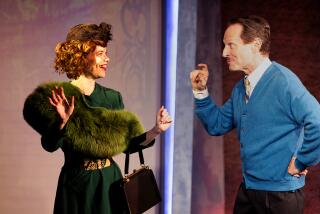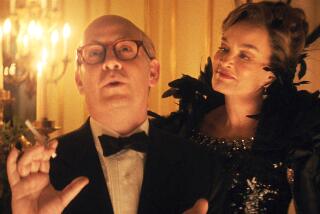Is Freud Dead?
- Share via
At the very beginning of the 20th century, as at its close, mainstream psychiatry has embraced a resolutely reductionist account of mental disorders, seeming to suggest that their psychological, social and moral dimensions may be safely set aside as the purely epiphenomenal accompaniments of an essentially biological condition. Sigmund Freud advanced a very different perspective on mental illness, of course. His vast theoretical edifice relentlessly sought meaning in madness and claimed, in finding it, to have discovered not just the key to the cure of the mentally unbalanced but the inner secrets of all human psychology, normal and pathological alike.
Provided one could swallow his premises, Freud’s system “made sense” of a whole range of phenomena previously left outside the realm of systematic observation. Psychoanalysis offered a new technology of treatment (“the talking cure”), a fascinating and appealing means of decoding the twilight world of dreams and everyday slips of the tongue, a new account of human nature and a plausible and apparently coherent account of behaviors commonsensically judged to be irrational. Moreover, his ideas could be presented in simplified terms to the simple yet could just as easily be dressed up in extraordinarily sophisticated garb for the sophisticated.
Particularly among Americans, the Freudian psychodynamic approach to mental disorder enjoyed an immense vogue in the quarter century or so following World War II. Via Dr. Benjamin Spock, its doctrines had an enduring impact on American child-rearing practices. The Hollywood dream factory (as Ann Kaplan makes clear in her chapter in Michael Roth’s “Freud: Conflict and Culture”) has repeatedly embraced and employed bowdlerized and bastardized versions of Freud’s ideas in any number of popular melodramas, from “The Snake Pit” through “Rebel Without a Cause” and “Ordinary People” to “Good Will Hunting.” After 1945, the commanding heights (if that’s the right term) of the psychiatric profession soon came to be occupied by the psychoanalytically inclined, and bestsellers like Robert Lindner’s “The Fifty-Minute Hour: A Collection of True Psychoanalytic Tales” further entrenched the link between psychiatry and the couch in popular culture and in America’s collective (un)consciousness. Anthropologists, political scientists and sociologists borrowed Freudian ideas. And affluent Americans sought psychic relief and enlightenment on the psychoanalytic couch.
In the final decades of the 20th century, however, psychoanalysis’ moment of triumph appears to have turned to ashes. Freud’s ideas never obtained much of a hearing among academic psychologists, and since the late ‘60s, psychoanalysis--the three or four 50-minute sessions each week, free associating about one’s dreams, one’s memories, one’s childhood--has been increasingly treated as an irrelevance by the psychiatric profession it once dominated. There remains a substantial--indeed growing--demand for counseling for the “worried well,” a market that psychoanalysis did much to create. But even here its practitioners have steadily lost ground to a burgeoning array of competitors. By the end of the ‘80s, outside the squabbling and sectarian ranks of analysts themselves, only an ill-assorted crowd of literary critics, fashionable French intellectuals, a segment of the feminist community and the cultural studies camp were disposed to argue for the continued vitality of the Freudian corpus. In other quarters, its status seemed more nearly that of an intellectual corpse.
Fortunately for Freud’s continued claim to cultural salience, however, over the last decade the psychodynamic view of human nature his followers insistently proclaim as his legacy has come under renewed assault from a vociferous and heterogeneous band of critics who, in the process of parading their passions, have unintentionally done much to secure the return of the repressed. Across the pages of the house journals of the North American intelligentsia--the New York Review of Books, the New Yorker and the New York Times--and in a flood of impassioned pamphlets and polemics, the Freud Wars have erupted. The three collections of essays under review here simply constitute the latest salvos in this scholarly trench warfare.
Bogged down in the mire of a mud-strewn battlefield, all of these books exude a somewhat stale and shopworn odor. All are stitched together from ideas and essays that have appeared in print before, and taken together they demonstrate all too plainly how the protagonists in this unsavory squabble have entered upon a dialogue of the deaf. Both critics and a handful of Freud’s dwindling band of defenders go through the motions of engaging in intellectual debate. But in an irony Freud might himself have appreciated, their respective interventions tend to have precisely the opposite of their intended effects.
Once a devotee, Frederick C. Crews, a former professor of literature at UC Berkeley, has recently been reincarnated as one of Freud’s most relentless foes. “Unauthorized Freud” is assembled from the work of 18 other scholars, whose various assaults upon the Freud legend are interspersed here with Crews’ own editorial commentary. Crews urges us to see these essays, stripped of their original scholarly apparatus and not always felicitously abridged, as revealing the essential emptiness of the Freudian enterprise. Psychoanalysis, he contends (borrowing the words of the late Sir Peter Medawar, a Nobel Prize-winning British physician), is nothing more than “a stupendous intellectual confidence trick.” Intellectually bankrupt and therapeutically useless or even actively harmful, it amounts to a “scientific fiasco” of astonishing proportions. As for Freud himself, he was personally and professionally disreputable and disingenuous, a charlatan rather than the “revolutionary genius” his followers proclaimed him to be. We have here, Crews insists, not the Copernicus or Darwin of the mind but a pseudo-scientist, foolish and unethical, self-deluding and deceptive, contemptuous of his patients and “eager to turn away the sick just as soon as he could afford to do so.” Winding himself up into a paroxysm of indignation, he exhorts us to dismiss his be^te noir as “a psychic Inspector Clousseau” (a comparison he might wish to rethink because, as I recall, the lovable and famously bumbling French detective always got things right in the end).
Presented in summary form, Crews’ book may sound like entertaining knockabout stuff, at the very least amounting to an amusingly one-sided polemic. In reality, much of the text is repetitive and wearisome to read and, ultimately, especially in the vindictive nastiness of its editorial commentary, counterproductive as critique. Freud notoriously sought to insulate his work from criticism by suggesting that an unwillingness to embrace his findings reflected not a reasoned rejection of his theories but an unconscious resistance to unpalatable truths. The more fiercely and passionately one protested that psychoanalysis was fallacious, the more one was unconsciously revealing the essential accuracy of its claims. Crews’ collection tempts even the skeptical to accord some plausibility to such suggestions. And then there is the uneven quality of the essays themselves--some (like Adolf Grunbaum on free association or Allen Esterson on the Dora case) thoughtful and penetrating, others (like Stanley Fish on the Wolf Man or Lavinia Edmunds on Freud’s relations with his American disciple, Horace Frink) thin and insubstantial. In seizing upon any weapon to assault Freud, Crews seems to hope that a reader who spurns one line of criticism will embrace another. To the contrary, the effect is to diminish and dilute even quite damaging critiques. Crews ought to have listened to his own intuition, which warned him (as he acknowledges in his preface) that “a book of this kind incurs the risk of overkill.”
If Crews is disposed to bury Freud, John Forrester’s mission, in “Dispatches from the Freud Wars,” a collection of his own previously published essays, is surely to rescue him. Deliverance is to be effected by activities on two fronts: conducting a frontal assault on Freud’s critics as ill-intentioned purveyors of “gratuitous slurs” who “pass off a deeply personal attack on Freud as . . . scholarly criticism” and attempting to rehabilitate selected portions of the master’s life and work. Neither strategy works very well.
Ad hominem attacks prove to be just as dubious a weapon when directed at Freud’s critics as they are when employed on the master himself. Much of the criticism that has appeared over the last quarter century is simply too sober and well-founded to be dismissed as motivated by malevolence--or by “unconscious” resistance to the truth. Even in the hands of a more acerbic and persuasive writer than Forrester, name-calling could not make transparent personal and intellectual failings disappear.
Matters only take a turn for the worse when “Dispatches” moves in more substantive directions. Those aware of the parlous state of much of what passes for humanistic scholarship these days will not draw precisely the conclusion Forrester seeks from his claim that “the presence of Freud in humanities departments . . . [constitutes] a true reflection of the character of Freud’s invention.” And what is one to make of the suggestion that we can view Freud’s status “as one of the best-selling authors of mass paperback nonfiction in the Western world today” as an index of his scientific achievement? Quite rightly, the distinguished philosopher Grunbaum labeled such desperate arguments (which other Freudians have employed elsewhere) as “bizarre. . . . Freud’s widespread cultural influence no more validates his tenets than Christian cultural hegemony warrants beliefs in the virgin birth of Jesus or in his resurrection.”
In still other places, Forrester’s own attempted glosses notwithstanding, the materials he presents inadvertently inflict quite devastating wounds on his hero. Nowhere is this more evident than in a chapter entitled “Casualties of Truth,” which deals centrally with Freud’s relations with his disciple Sandor Ferenczi. For years, with Freud’s active and essential connivance and assistance, Ferenczi conducted a long-running affair with a married woman who was his brother’s mother-in-law (sleeping also with her sister when the occasion arose); analyzed and simultaneously seduced her daughter (whom he considered his “breeding stock”); and, once engaged to the latter, continued his sexual escapades with the parent. And on and on, in an appalling true-life reenactment of Arthur Schnitzler’s “La Ronde.” Freud not only encouraged this incestuous menage-a-trois (or quatre), intervening at times to forward the sexual claims of the mother and at others those of the daughter: When things got seriously sticky, and at Ferenczi’s request, he himself took on the daughter as an analysand, employing the therapeutic situation “to seduce the young Elma” for his friend and disciple. “At no point,” we are informed, did Freud consider Ferenczi’s request (or presumably his own behavior in this matter) “illicit or transgressive.” Forrester seems satisfied with Freud’s view of sexual relations between patient and analyst “as primarily a pragmatic question, presenting no more moral implications to the analyst than the handling of explosive substances presents to the chemist,” and he condemns “the recently refurbished sanctimoniousness of the liberal professions” on the subject--the objections of lawyers and mental health professionals to sexual relations between patient and therapist. Others may choose to draw a rather different set of conclusions from this dismal story of exploitation and immorality.
Finally, there is Michael S. Roth’s “Freud: Conflict and Culture.” Roth’s book is not just a further salvo in the Freud Wars but is in some sense a product of them. Another edited collection, the book was intended to serve as a catalog accompanying the recent Library of Congress exhibit on Freud. The Freud show has had a complicated history. Originally planned for 1995, it ran into a firestorm of protest from a wide spectrum of critics who were convinced that, with an advisory committee stacked with Freudian sympathizers, it would amount to nothing more than government-financed propaganda on behalf of psychoanalysis and its founder.
In the midst of the furor, budget-cutting caused the cancellation of the exhibition, and the critics found themselves assailed as mean-spirited censors. It should be noted that such accusations were not only inaccurate but required immense amounts of chutzpah, given how assiduously Freud’s followers have manipulated and suppressed inconvenient aspects of the historical record since his death: destroying some documents and rendering others (including papers housed at the Library of Congress) inaccessible to outsiders for decades. Anna Freud, for example, bluntly insisted that “we can always suppress what is too personal” and fought for years to ensure that only suitably expurgated versions of the Freud-Ferenczi correspondence saw the light of day; and the guardians of the Freud Archives successfully sequestered the similarly damaging correspondence with Wilhelm Fliess till they foolishly entrusted their secrets to the rogue analyst Jeffrey Masson.
At all events, money has now been found, a compromise has been struck with at least some critics, the exhibit has been mounted and its curator, Roth, has assembled his book. “Freud: Conflict and Culture” is a deeply schizophrenic production. Roth has claimed, in a New York Times interview, that he is a partisan of neither side in the Freud Wars, but one wonders. Certainly, the first three quarters of the book suggest that the original critics of the show were absolutely correct in their suspicions of what was in the works. In serried ranks, the faithful parade their loyalty to the sacred texts and the Founding Father. There are essays by the director of the Freud Archives, by the research director of the Freud Museum, by a supervising and training analyst from the Canadian Institute of Psychoanalysis, by a member of the Houston-Galveston Psychoanalytic Institute and by two other well-known American analysts. With an assist from a comic strip artist (who “entertains” us with a heavy-handed series of drawings illustrating the nature of humor), half a dozen suitably sympathetic scholars (their devotion to the cause amply vouched for by prior publications) round out the remarkably unbalanced cast of contributors.
Reading most of these essays, a naive audience would assume the whole Freudian enterprise has largely stood the test of time without encountering serious criticism. Indeed, Edith Kurzweil, celebrating (largely unspecified) “advances in psychoanalytic knowledge,” informs us that in 1998 “the main concepts of psychoanalysis are widely accepted [and] Freud has irrevocably altered the Western tradition.” Though in a few places there is an acknowledgment that resistance has been forthcoming (as Peter Gay concedes it has among historians), the failure to embrace psychoanalysis is portrayed as history’s loss. And when damaging material is broached, as in Hannah Decker’s piece on the “Dora” case, a therapeutic and ethical debacle is explained away by an author determined to portray Freud in the most favorable light possible.
Only in the book’s concluding section is there serious engagement with the controversy that swirls around Freud and psychoanalysis. Setting to one side a psychoanalytic feminist from New York (who contributes an incoherent and almost unreadable essay praising psychoanalysis for providing “the subversive opportunity of digging up the ground beneath your feet”), the remaining contributors consist of a handful of those who protested against the original plans for the exhibit. In token fashion, they are here allowed to present their views.
Though a couple of these authors entered into the spirit of the occasion and produced trite and somewhat celebratory pieces, Frank Cioffi and Grunbaum will have none of it. Their criticisms are trenchant and far-reaching, and though the latter recognizes some continuing heuristic role for psychoanalysis, neither author paints a very rosy picture of its current standing or its future prospects. Regardless of whether one accepts their critiques or not, Cioffi and Grunbaum’s analyses throw into stark relief how one-sided and willfully partisan much of the book is.
A vast array of scholarship shows that Freud was a deeply flawed thinker and an even more profoundly flawed human being. For all that, his doctrines have made an indelible mark on the 20th century. We should doubtless feel pity for those who continue to worship blindly at his shrine. But to dismiss him as merely an immoral charlatan would be both simplistic and wrong. When the Freud Wars end, all indications are that psychoanalysis will resume its steady decline. Yet the puzzles that surround Freud and his system will remain, and they will unquestionably form an essential part of any cultural history of our times. Furthermore, though psychoanalysis may indeed have been a blind alley, its founder’s insistence on taking seriously the psychological and social dimensions of mental disturbance surely ought to (and will) survive.


